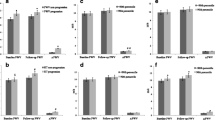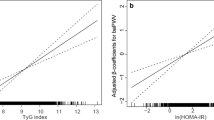Abstract
Aims
LDL cholesterol (LDL-C) is the current lipid standard for cardiovascular disease (CVD)-risk assessment in type 1 diabetes. Apolipoprotein B (apoB) may be helpful to further stratify CVD risk. We explored the association between apoB and pulse wave velocity (PWV) to determine if apoB would improve CVD-risk stratification, especially in type 1 diabetes adolescents with borderline LDL-C (100–129 mg/dL). We hypothesized that type 1 diabetes adolescents with borderline LDL-C and elevated apoB (≥90 mg/dL) would have increased PWV compared to those with borderline LDL-C and normal apoB (<90 mg/dL), and that apoB would explain more of the variability of PWV than alternative lipid indices.
Methods
Fasting lipids, including apoB, were collected in 267 adolescents, age 12–19 years, with diabetes duration >5 years and HbA1c 8.9 ± 1.6 %. Triglyceride to HDL-C ratio (TG/HDL-C) and nonHDL-cholesterol (nonHDL-C) were calculated. PWV was measured in the carotid–femoral segment.
Results
ApoB, nonHDL-C and TG/HDL-C correlated with PWV (p < 0.0001). ApoB, nonHDL-C and TG/HDL-C remained significantly associated with PWV in fully adjusted models. In adolescents with borderline LDL-C (n = 61), PWV was significantly higher in those with elevated apoB than in those with normal apoB (5.6 ± 0.6 vs. 5.2 ± 0.6 m/s, p < 0.01) and also remained significant after adjustment for CVD-risk factors (p = 0.0002). Moreover, in those with borderline LDL-C, apoB explained more of the variability of PWV than nonHDL-C and TG/HDL-C.
Conclusion
Elevated apoB is associated with increased arterial stiffness in type 1 diabetes adolescents. Measurement of apoB in addition to LDL-C may be helpful in stratifying CVD risk in type 1 diabetes adolescents, especially in those with borderline LDL-C.


Similar content being viewed by others
References
Federation ID: Diabetes Atlas (2007)
Schwab KO, Doerfer J, Hecker W, Grulich-Henn J, Wiemann D, Kordonouri O, Beyer P, Holl RW (2006) Spectrum and prevalence of atherogenic risk factors in 27,358 children, adolescents, and young adults with type 1 diabetes: cross-sectional data from the German diabetes documentation and quality management system (DPV). Diabetes Care 29:218–225
Margeirsdottir HD, Larsen JR, Brunborg C, Overby NC, Dahl-Jorgensen K (2008) High prevalence of cardiovascular risk factors in children and adolescents with type 1 diabetes: a population-based study. Diabetologia 51:554–561
Bjornstad P, Wadwa RP (2014) Risks and benefits of statin use in young people with type 1 diabetes. Curr Diabetes Rep 14:499
Strong JP, Malcom GT, McMahan CA, Tracy RE, Newman WP III, Herderick EE, Cornhill JF (1999) Prevalence and extent of atherosclerosis in adolescents and young adults: implications for prevention from the Pathobiological Determinants of Atherosclerosis in Youth Study. JAMA 281:727–735
Berenson GS, Srinivasan SR, Bao W, Newman WP III, Tracy RE, Wattigney WA (1998) Association between multiple cardiovascular risk factors and atherosclerosis in children and young adults. The Bogalusa Heart Study. N Engl J Med 338:1650–1656
Kershnar AK, Daniels SR, Imperatore G, Palla SL, Petitti DB, Pettitt DJ, Marcovina S, Dolan LM, Hamman RF, Liese AD, Pihoker C, Rodriguez BL (2006) Lipid abnormalities are prevalent in youth with type 1 and type 2 diabetes: the SEARCH for Diabetes in Youth Study. J Pediatr 149:314–319
Wood JR, Miller KM, Maahs DM, Beck RW, Dimeglio LA, Libman IM, Quinn M, Tamborlane WV, Woerner SE (2013) Most youth with type 1 diabetes in the T1D exchange clinic registry do not meet American Diabetes Association or International Society for Pediatric and Adolescent Diabetes Clinical Guidelines. Diabetes Care 36:2035–2037
Davis PH, Dawson JD, Riley WA, Lauer RM (2001) Carotid intimal-medial thickness is related to cardiovascular risk factors measured from childhood through middle age: the Muscatine Study. Circulation 104:2815–2819
Raitakari OT, Juonala M, Kahonen M, Taittonen L, Laitinen T, Maki-Torkko N, Jarvisalo MJ, Uhari M, Jokinen E, Ronnemaa T, Akerblom HK, Viikari JS (2003) Cardiovascular risk factors in childhood and carotid artery intima-media thickness in adulthood: the Cardiovascular Risk in Young Finns Study. JAMA 290:2277–2283
Koivistoinen T, Hutri-Kahonen N, Juonala M, Koobi T, Aatola H, Lehtimaki T, Viikari JS, Raitakari OT, Kahonen M (2011) Apolipoprotein B is related to arterial pulse wave velocity in young adults: the Cardiovascular Risk in Young Finns Study. Atherosclerosis 214:220–224
Albers JJ, Marcovina SM, Imperatore G, Snively BM, Stafford J, Fujimoto WY, Mayer-Davis EJ, Petitti DB, Pihoker C, Dolan L, Dabelea DM (2008) Prevalence and determinants of elevated apolipoprotein B and dense low-density lipoprotein in youths with type 1 and type 2 diabetes. J Clin Endocrinol Metab 93:735–742
Mancera-Romero J, Sanchez-Chaparro MA, Rioja J, Ariza MJ, Olivecrona G, Gonzalez-Santos P, Valdivielso P (2013) Fasting apolipoprotein B48 is a marker for peripheral arterial disease in type 2 diabetes. Acta Diabetol 50:383–389
Guy J, Ogden L, Wadwa RP, Hamman RF, Mayer-Davis EJ, Liese AD, D’Agostino R Jr, Marcovina S, Dabelea D (2009) Lipid and lipoprotein profiles in youth with and without type 1 diabetes: the SEARCH for diabetes in youth case-control study. Diabetes Care 32:416–420
Vlachopoulos C, Aznaouridis K, Stefanadis C (2010) Prediction of cardiovascular events and all-cause mortality with arterial stiffness: a systematic review and meta-analysis. J Am Coll Cardiol 55:1318–1327
Brown TL, Snell-Bergeon J, Maahs D, Bishop FK, Prentice N, Aragon B, Wadwa P (2011) Loss of female cardiovascular protection in type 1 diabetes may begin in adolescence. Diabetes 60(Suppl):1
Marshall WA, Tanner JM (1970) Variations in the pattern of pubertal changes in boys. Arch Dis Child 45:13–23
American Diabetes Association (2014) Standards of medical care in diabetes. Diabetes Care 37(Suppl 1):S14-S80
Brunzell JD, Davidson M, Furberg CD, Goldberg RB, Howard BV, Stein JH, Witztum JL (2008) Lipoprotein management in patients with cardiometabolic risk: consensus conference report from the American Diabetes Association and the American College of Cardiology Foundation. J Am Coll Cardiol 51:1512–1524
Shrout PE, Fleiss JL (1979) Intraclass correlations: uses in assessing rater reliability. Psychol Bull 86:420–428
Weber T, Auer J, O’Rourke MF, Kvas E, Lassnig E, Berent R, Eber B (2004) Arterial stiffness, wave reflections, and the risk of coronary artery disease. Circulation 109:184–189
Urbina EM, Williams RV, Alpert BS, Collins RT, Daniels SR, Hayman L, Jacobson M, Mahoney L, Mietus-Snyder M, Rocchini A, Steinberger J, McCrindle B (2009) Noninvasive assessment of subclinical atherosclerosis in children and adolescents: recommendations for standard assessment for clinical research: a scientific statement from the American Heart Association. Hypertension 54:919–950
Haller MJ, Samyn M, Nichols WW, Brusko T, Wasserfall C, Schwartz RF, Atkinson M, Shuster JJ, Pierce GL, Silverstein JH (2004) Radial artery tonometry demonstrates arterial stiffness in children with type 1 diabetes. Diabetes Care 27:2911–2917
Sachdeva A, Cannon CP, Deedwania PC, Labresh KA, Smith SC Jr, Dai D, Hernandez A, Fonarow GC (2009) Lipid levels in patients hospitalized with coronary artery disease: an analysis of 136,905 hospitalizations in Get With The Guidelines. Am Heart J 157(111–117):e112
Libby P (2005) The forgotten majority: unfinished business in cardiovascular risk reduction. J Am Coll Cardiol 46:1225–1228
Martin SS, Michos ED (2014) Are we moving towards concordance on the principle that lipid discordance matters? Circulation 129:539–541
Barter PJ, Ballantyne CM, Carmena R, Cabezas MC, Chapman MJ, Couture P, de Graaf J, Durrington PN, Faergeman O, Frohlich J, Furberg CD, Gagne C, Haffner SM, Humphries SE, Jungner I, Krauss RM, Kwiterovich P, Marcovina S, Packard CJ, Pearson TA, Reddy KS, Rosenson R, Sarrafzadegan N, Sniderman AD, Stalenhoef AF, Stein E, Talmud PJ, Tonkin AM, Walldius G, Williams KM (2006) Apo B versus cholesterol in estimating cardiovascular risk and in guiding therapy: report of the thirty-person/ten-country panel. J Intern Med 259:247–258
Sharrett AR, Ballantyne CM, Coady SA, Heiss G, Sorlie PD, Catellier D, Patsch W (2001) Coronary heart disease prediction from lipoprotein cholesterol levels, triglycerides, lipoprotein(a), apolipoproteins A-I and B, and HDL density subfractions: the Atherosclerosis Risk in Communities (ARIC) Study. Circulation 104:1108–1113
Bao W, Srinivasan SR, Berenson GS (1993) Tracking of serum apolipoproteins A-I and B in children and young adults: the Bogalusa Heart Study. J Clin Epidemiol 46:609–616
Ramjee V, Sperling LS, Jacobson TA (2011) Non-high-density lipoprotein cholesterol versus apolipoprotein B in cardiovascular risk stratification: do the math. J Am Coll Cardiol 58:457–463
Walldius G, Jungner I, Holme I, Aastveit AH, Kolar W, Steiner E (2001) High apolipoprotein B, low apolipoprotein A-I, and improvement in the prediction of fatal myocardial infarction (AMORIS study): a prospective study. Lancet 358:2026–2033
McQueen MJ, Hawken S, Wang X, Ounpuu S, Sniderman A, Probstfield J, Steyn K, Sanderson JE, Hasani M, Volkova E, Kazmi K, Yusuf S (2008) Lipids, lipoproteins, and apolipoproteins as risk markers of myocardial infarction in 52 countries (the INTERHEART study): a case-control study. Lancet 372:224–233
Albers JJ, Slee A, O’Brien KD, Robinson JG, Kashyap ML, Kwiterovich PO Jr, Xu P, Marcovina SM (2013) Relationship of apolipoproteins A-1 and B, and lipoprotein(a) to cardiovascular outcomes: the AIM-HIGH trial (atherothrombosis intervention in metabolic syndrome with low HDL/high triglyceride and impact on global health outcomes). J Am Coll Cardiol 62:1575–1579
Juonala M, Viikari JS, Kahonen M, Solakivi T, Helenius H, Jula A, Marniemi J, Taittonen L, Laitinen T, Nikkari T, Raitakari OT (2008) Childhood levels of serum apolipoproteins B and A-I predict carotid intima-media thickness and brachial endothelial function in adulthood: the cardiovascular risk in young Finns study. J Am Coll Cardiol 52:293–299
Urbina EM, Khoury PR, McCoy CE, Dolan LM, Daniels SR, Kimball TR (2013) Triglyceride to HDL-C ratio and increased arterial stiffness in children, adolescents, and young adults. Pediatrics 131:e1082–e1090
Ingelsson E, Schaefer EJ, Contois JH, McNamara JR, Sullivan L, Keyes MJ, Pencina MJ, Schoonmaker C, Wilson PW, D’Agostino RB, Vasan RS (2007) Clinical utility of different lipid measures for prediction of coronary heart disease in men and women. JAMA 298:776–785
Di Angelantonio E, Sarwar N, Perry P, Kaptoge S, Ray KK, Thompson A, Wood AM, Lewington S, Sattar N, Packard CJ, Collins R, Thompson SG, Danesh J (2009) Major lipids, apolipoproteins, and risk of vascular disease. JAMA 302:1993–2000
Mora S, Buring JE, Ridker PM (2014) Discordance of low-density lipoprotein (LDL) cholesterol with alternative LDL-related measures and future coronary events. Circulation 129:553–561
Expert panel on integrated guidelines for cardiovascular health and risk reduction in children and adolescents: summary report. Pediatrics 2011;128(Suppl 5):S213–56
Mazanderani AB, Wise SJ, Tildesley HD (2009) Apolipoprotein B levels in adults with type 1 diabetes not receiving lipid-lowering therapy. Clin Biochem 42:1218–1221
Sniderman AD, St-Pierre AC, Cantin B, Dagenais GR, Despres JP, Lamarche B (2003) Concordance/discordance between plasma apolipoprotein B levels and the cholesterol indexes of atherosclerotic risk. Am J Cardiol 91:1173–1177
Sniderman A, Williams K, Cobbaert C (2009) ApoB versus non-HDL-C: what to do when they disagree. Curr Atheroscler Rep 11:358–363
Acknowledgments
Drs. R. Paul Wadwa and Petter Bjornstad, and Ms. Nhung Nguyen are guarantors of this work and, as such, had full access to all the data in the study and take responsibility for the integrity of the data and the accuracy of the data analysis. Support for this study was provided by NIDDK grants (T32DK06387, DK075360), JDRF (11-2007-694) and CTSI UL-1 RR025780. The study was performed at the Barbara Davis Center for Childhood Diabetes, Aurora, CO. Dr. Maahs was supported by a grant from NIDDK (DK075360), Dr. Snell-Bergeon by an American Diabetes Association Junior Faculty Award (1-10-JF-50) and Dr. Wadwa by an early career award from the Juvenile Diabetes Research Foundation (11-2007-694). The authors have no financial relationships relevant to this article to disclose.
Conflict of interest
The authors declare that they have no conflict of interest.
Human and animal rights disclosure
All procedures followed were in accordance with the ethical standards of the responsible committee on human experimentation (institutional and national) and with the Helsinki Declaration of 1975, as revised in 2008.
Informed consent disclosure
Informed consent and assent were obtained from all patients included in the study.
Author information
Authors and Affiliations
Corresponding author
Additional information
Managed by Antonio Secchi.
Rights and permissions
About this article
Cite this article
Bjornstad, P., Nguyen, N., Reinick, C. et al. Association of apolipoprotein B, LDL-C and vascular stiffness in adolescents with type 1 diabetes. Acta Diabetol 52, 611–619 (2015). https://doi.org/10.1007/s00592-014-0693-9
Received:
Accepted:
Published:
Issue Date:
DOI: https://doi.org/10.1007/s00592-014-0693-9




